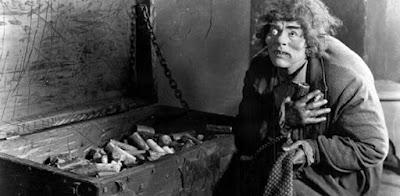Format: Internet video on Fire!

There are a lot of holes in my viewing history, something that is certainly true of just about everyone. For the sort of bog-standard “everyone’s seen them” films, my biggest gaps are probably Home Alone and The Goonies. For horror movies, the original 1923 Lon Chaney version of The Hunchback of Notre Dame was probably my biggest miss until now. I’ve seen other versions, notably the 1939 version with Charles Laughton, but this one is, in the slang of a few decades ago, the O.G.
There’s a lot to unpack right at the start with something like The Hunchback of Notre Dame. It’s one of those rare stories that everyone seems to know even if they haven’t seen it or read it. It’s kind of like Robin Hood in that respect—there’s a sort of cultural knowledge of the story that we learn by osmosis. Of course, some of that is going to come from the title. We know going in that this is going to take place in Paris and that there’s going to be a hunchback who is our main character. Of course today, people are going to associate this story with the Disney version, including plenty of songs and animated gargoyle sidekicks.
We’re going to deviate from the original novel in some significant ways in this first version of the film. Main characters will have names changed. In the original story, our main antagonist will be the Archdeacon of Notre Dame, Claude Frollo. Frollo doesn’t appear in this version of the film. Not wanting to offend the church in any way, we’re instead given the saintly Don Claudio (Nigel De Brulier) and his evil brother Jehan (Brandon Hearst). It is Jehan who will become besotted with the lovely Roma girl Esmeralda (Patsy Ruth Miller) and will send his charge Quasimodo (Lon Chaney) to capture her.
Quasimodo, of course, is our title character. Half-blind, mostly deaf and horribly disfigured. Quasimodo’s only joy is the bells of the cathedral. When he is stopped from kidnapping Esmeralda by the noble Phoebus de Chateaupers (Norman Kerry), a set of events is set in motion. Esmeralda and Phoebus fall in love, which causes her adoptive father Clopin (Ernest Torrence) to want to kill Phoebus to protect her. It also causes Jehan to want to Esmeralda even more. And, when Esmeralda shows pity on Quasimodo as he is being whipped in the square, he naturally becomes enraptured with her as well.
Ultimately, that is the full story here. Everyone is in love with Esmeralda, who wants only to dedicate her life to the church if Clopin will not let her be with Phoebus. Jehan is of the opinion that if he can’t have Esmeralda, no one can, and he stabs Phoebus, setting her up to take the fall, and because of 15th century justice, to be killed for the crime she didn’t commit. And, just as justice is about to be meted out, Quasimodo swings in, captures Esmeralda, and demands sanctuary in the cathedral.
Of course, as a film that is now literally 100 years old, there’s a lot here that is extremely dated. That’s true in large part simply because this is a silent film and is going to be wrapped up in that world in large part because of the era. We’re going to see a lot of gesturing to make points, and a lot of overacting to get those points across. You can expect that going in as much as you like, but it’s still not going to play across the screen as anything but excessive in a lot of ways.
The star here is, of course, Lon Chaney, who transforms himself completely into the role of Quasimodo. Chaney’s genius was his ability to disappear completely in a role and become absolutely indistinguishable from his other roles. Quasimodo looks nothing like Eric the phantom, or the clown from Laugh, Clown, Laugh. Every other version of Quasimodo is affected by this one, and while the one obviously blind eye seems to be something that is really only present here, the rest is iconic to the role and a part of every other version of the character.
The ending, of course, is different than the book. The book has a complete downer ending (I won’t spoil it, but to say that it’s wholly tragic and clearly romantic in the original sense), and the ending here is only partially a downer. This is again likely a product of the time, but certainly not nearly as distant from the original as Disney.
This is an important film for a lot of reasons. It’s arguably a bit too long, but it builds up to some pretty great scenes of crowds attacking Notre Dame at the end, which makes it all worth it.
Why to watch The Hunchback of Notre Dame: Lon Chaney.
Why not to watch: Big deviations from the original text.
